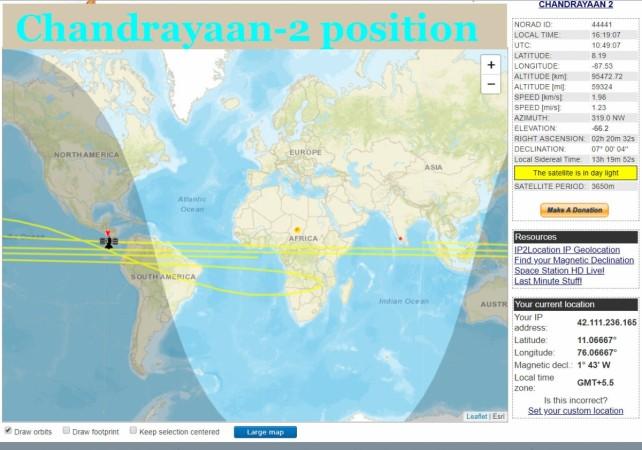
Tension is rising among India's scientific community as the Indian Space Research Organisation's (ISRO) Moon Mission, Chandrayaan-2, is set to leave the Earth's gravitational field in a few hours. The composite spacecraft that carries a lander, Vikram, and a rover, Pragyaan, will be pointed on a translunar course in a critical manoeuvre on Wednesday between 3 am and 4 am.
Launching the spacecraft to beyond the Earth's orbit and insert it on an orbit that will take it to Moon's orbit is extremely critical because without the right timings Chandrayaan-2 could miss intersection of the Moon's orbit and could be lost forever, experts say. The purpose of the translunar insertion is to take the orbiter close enough to the Moon so that it gets trapped by the gravitational field of the Earth's lone satellite.
ISRO chairman Dr K Sivan told the media the other day that ISRO expected Chandrayaan-2 to begin going around the Moon from August 20. The soft-landing of Vikram on the lunar surface is expected on September 7 where it will release the rover Pragyaan to do a range of experiments.
The 3,850kg Chandrayaan-2 was put on the orbit by India's most powerful rocket GSLV-Mk3 in a textbook launch from the second launch pad of ISRO's Satish Dhawan Space Centre (SDSC) in Sriharikota on July 22. The launch was initially scheduled on July 19's 10-minute launch window but moved after a glitch was noticed on the cryogenic stage with less than one hour to go for the ignition. ISRO engineers did a creditable job rectifying the problem in a short time to fire the rocket in the one-minute launch window on July 22.

A few minutes after the launch, the GSLV-Mk3 ejected the spacecraft on the geostationary transfer orbit (GTO) of about 35,000km from where Chadrayaan-2 was lifted to the current elliptical orbit with the fifth and last orbit raising manoeuvre. Currently, Chandrayaan-2 is orbiting the earth on an orbit that takes it to an altitude of 142,975km from the Earth at the farthest point (apogee) and brings its as close as 276km at the nearest point (perigee), according to the ISRO website.
"After launching Chandrayaan-2 on July 22, we did five manoeuvres. The Chandrayaan-2 composite body is now revolving around the earth," Sivan said. "At around 3:30 am on August 14, we are going to have a manoeuvre called trans-lunar injection. By this manoeuvre, the Chandrayaan-2 will leave the earth and move towards the moon. On August 20, we will be reaching the moon," he said.
The ISRO head said the engineers will do a series of manoeuvres around the moon culminating on Vikram's soft-landing on the Moon's surface on September 7 at a spot near the lunar south pole, which will be a first in the world's spacefaring history. According to Sivan, the spacecraft is "doing very well" and all its systems are functioning properly. The 1.44-tonne Vikram, made by Russian Federal Space Agency, would carry the 27kg Indian-made rover Pragyan that moves on six wheels to the lunar surface for scientific exploration.









